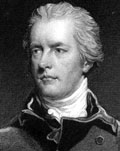 |
William Pittb. 28 May 1759, Hayes, Kent |
| Ministerial offices: | Chancellor of the Exchequer (13 Jul 1782 - 5 Apr 1783, 27 Dec 1783 - 21 Mar 1801, 10 May 1804 - 23 Jan 1806) |
| First Lord Commissioner of the Treasury and Leader of the House of Commons (19 Dec 1783 - 14 Mar 1801, 10/12 May 1804 - 23 Jan 1806) [1] | |
| Names/titles: | Also known as: Pitt "the Younger" |
| Biography: | |
William Pitt was the second son of the Earl of Chatham and the nephew of George Grenville by his mother. He studied at Pembroke Hall, Cambridge, and received the degree of Master of Arts without examination. Then he was trained as a lawyer at Lincoln's Inn and was called to the bar in 1780. Elected (8 Jan 1781) to the House of Commons for Appleby at the age of twenty-one, Pitt took his seat on 23 Jan 1781 and was continuously reelected as MP until his death. Pitt became Chancellor of the Exchequer (1782-1783) in the government of the Duke of Shelburne just eighteen months after he entered Parliament. Within another eighteen months he accepted the office of First Lord of the Treasury (19 Dec 1783) and became prime minister also assuming the office of Chancellor of the Exchequer (1783-1801). He supported parliamentary reform and free trade. His Cabinet, made up of peers only, was not impressive but Pitt himself was very effective — undertaking the King's business, reforming national finances notably excise duties and replacing expensive sinecures with peerages. Following the attacks of Charles James Fox and his supporters on the Pitt's administration, Pitt insisted on dissolving Parliament (25 Mar 1784) and won the general elections in 1784. Pitt was returned for the Cambridge University, the seat which he continued to represent for the rest of his life. In 1785 Pitt introduced a bill on parliamentary reform but it was defeated. By changing the administration of India, Canada and the emerging Australia, he helped develop imperial alternatives to the now-independent United States. On 1 Feb 1793 France declared war on Britain and Holland. The allies' military weakness and unpreparedness was later ameliorated by treaties with Russia, Prussia, Austria, Spain, Sardinia and Naples. Pitt was not so successful as a war leader, as his idea of a grand alliance against France was destroyed by the disintegration of the alliance. In May-June 1798 a rebellion broke out in Ireland, prompted by fear of British coercion in the South, and in anticipation of French assistance. On 1 Aug 1798, the victory of Admiral Nelson over the French in the battle of the Nile assisted Pitt's formation of the Second Coalition against France, which by the end of the year, comprised Britain, Portugal, Naples, Russia and the Porte. After the Act of Union with Ireland was enacted on 2 Jul 1800, Pitt's Irish policy led to a clash with the King. As Pitt sought to link the union with gradual Catholic Emancipation, he tendered his resignation on 3 Feb 1801, which was accepted on 14 Mar 1801. When Pitt resigned he supported Henry Addington as prime minister, but soon became a critic of the Government and mounted opposition, which brought about Addington's resignation. On 10/12 May 1804 Pitt was again appointed First Lord of the Treasury and became prime minister, but his second administration was weaker than the first. By the summer of 1805 Pitt engineered the Third Coalition, with Russia, Sweden and Austria, against France. However, in spite of Nelson's success at Trafalgar (21 Oct 1805), the victories of Napoléon I at Ulm (20 Oct 1805) and at Austerlitz (2 Dec 1805) put the coalition on the edge of collapse. Pitt grew increasingly ill and died in office on 23 Jan 1806 at the age of forty-six. Biography source: [2, pp. 75-82] |
|
| | |
| [1] | According to "Annual Register" (1804, 459) the date was 12 May 1804, but it seems to be the date of gazetting; "Dictionary of National Biographies" says 10 May 1804 (See [3, p. 114]). |
| [2] | Englefield, Dermot; Seaton, Janet; White, Isobel (eds.) Facts About the British Prime Ministers: A Compilation of Biographical and Historical Information. New York: The H.W. Wilson Company, 1995. online |
| [3] | Fryde, E.B., et al. (eds.) Handbook of British Chronology. London: Offices of the Royal Historical Society: University College, 1986. 3rd edition. online |
| Image: steel engraving of William Pitt the Younger after the painting by John Hoppner. | |
